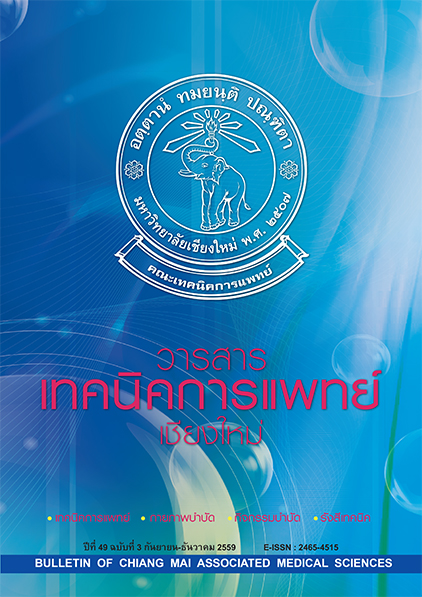Relationship between lower limb muscle strength and balance measured by Star Excursion Balance Test in obese young adults
Main Article Content
Abstract
Objectives: The purpose of this study was to determine whether lower limb muscle strength affects dynamic balance in obese young adults by exploring the relationship between variables obtained from Star Excursion Balance Test (SEBT). Six groups of lower limb muscle strength was obtained from Push-pull dynamometer.
Materials and methods: Thirty young adult participants with obesity (15 males and 15 females) were recruited in this study. Star Excursion Balance Test (SEBT) was performed and strength of six groups of lower limb muscles was measured using Push-pull dynamometer. Pearson’s product moment correlation coefficient statistic was used to determine the relationship between these variables. The significant level was set at p<0.05.
Results: The result showed that SEBT score was moderate to strong correlation with knee flexor and knee extensor strength (r=0.507, p=0.002 and r=0.693, p=0.00, respectively) and weak correlation with ankle plantarflexor strength (r=0.342, p=0.032). There was no correlation between SEBT score and hip flexor, hip extensor and ankle dorsiflexor strength.
Conclusion: Lower limb muscle strength is an important factor that affects dynamic balance in obese young adults.
Bull Chiang Mai Assoc Med Sci 2016; 49(2): 355-362. Doi: 10.14456/jams.2016.33
Article Details
Personal views expressed by the contributors in their articles are not necessarily those of the Journal of Associated Medical Sciences, Faculty of Associated Medical Sciences, Chiang Mai University.
References
2. Aekplakorn W, Mo-Suwan L. Prevalence of obesity in Thailand. Obes Rev 2009; 10: 589-92.doi: 10.1111/j.1467-789X.2009.00626.x.
3. Lang IA, Llewellyn DJ, Alexander K, Melzer D. Obesity, physical function, and mortality in older adults. J Am Geriatr Soc 2008; 56: 1474-8.doi: 10.1111/j.1532-5415.2008.01813.x.
4. Bethesda. Clinical guidelines on the Identification, evaluation, and treatment of overweight and obesity in adults: The evidence report: NHLBI obesity education initiative expert panel on the identification, evaluation, and treatment of obesity in adults (US); 1988 [cited 2015 september 07]. Available from: http://www.ncbi.nlm.nih.gov/books/NBK1995/
5. Wang L, Li JX, Xu DQ, Hong YL. Proprioception of ankle and knee joints in obese boys and nonobese boys. Med Sci Monit 2008; 14: CR129-35.
6. Sturnieks DL, St George R, Lord SR. Balance disorders in the elderly. Neurophysiol Clin 2008; 38: 467-78.doi: 10.1016/j.neucli.2008.09.001.
7. Matter KC, Sinclair SA, Hostetler SG, Xiang H. A comparison of the characteristics of injuries between obese and non-obese inpatients. Obesity (Silver Spring) 2007; 15: 2384-90.
8. Singh D, Park W, Levy MS, Jung ES. The effects of obesity and standing time on postural sway during prolonged quiet standing. Ergonomics 2009; 52: 977-86.doi: 10.1080/00140130902777636.
9. Haakonssen EC. The association of obesity and muscle stregth and power with the ability to recover balance from a forward leaning position [Master thesis]. North Carolina, United States: Wake Forest Univesity; 2010.
10. Corbin. C, Welk. G, Corbin. W, Welk. K. Concepts of physical fitness: active lifestyles for wellness. New York: McGraw-Hill Publishing; 2013.
11. Manual guide of baseline® push-pull dynamometer for muscle strength testing. New York: Fabication Enterprises Incorporated.
12. Gribble PA, Hertel J, Plisky P. Using the star excursion balance test to assess dynamic postural-control deficits and outcomes in lower extremity injury: aliterature and systematic review. J Athl Train 2012; 47: 339-57. doi: 10.4085/1062-6050-47.3.08.
13. Bouillon LE, Baker JL. Dynamic balance differences as measured by the star excursion balance test between adult-aged and middle-aged women. Sports Health 2011; 3: 466-9.
14. Filipa A, Byrnes R, Paterno MV, Myer GD, Hewett TE. Neuromuscular training improves performance on the star excursion balance test in young female athletes. J Orthop Sports Phys Ther 2010; 40: 551-8.doi: 10.2519/jospt.2010.3325.
15. Coughlan GF, Fullam K, Delahunt E, Gissane C, Caulfield BM. A comparison between performance on selected directions of the star excursion balance Test and the Y Balance Test. J Athl Train 2012; 47: 366-71. doi: 10.4085/1062-6050-47.4.03.
16. Wolfson L, Judge J, Whipple R, King M. Strength is a major factor in balance, gait, and the occurrence of falls. J Gerontol A Biol Sci Med Sci 1995; 50: 64-7.
17. Son SM, Park MK, Lee NK. Influence of resistance exercise training to strengthen muscles across multiple joints of the lower limbs on dynamic balance functions of stroke patients. J Phys Ther Sci 2014; 26: 1267-9.
18. Schenkman M, Berger RA, Riley PO, Mann RW, Hodge WA. Whole-body movements during rising to standing from sitting. Phys Ther 1990; 70: 638-48.
19. Khemlani MM, Carr JH, Crosbie WJ. Muscle synergies and joint linkages in sit-to-stand under two initial foot positions. Clin Biomech 1999; 14: 236-46.


